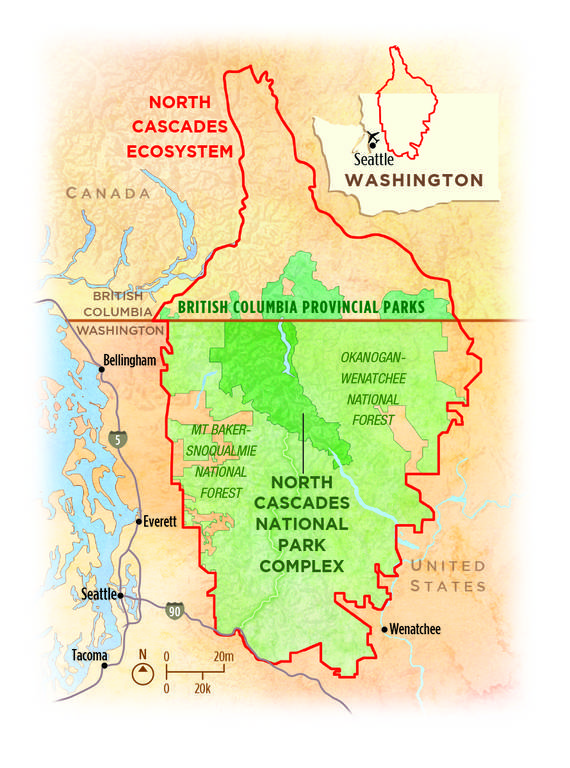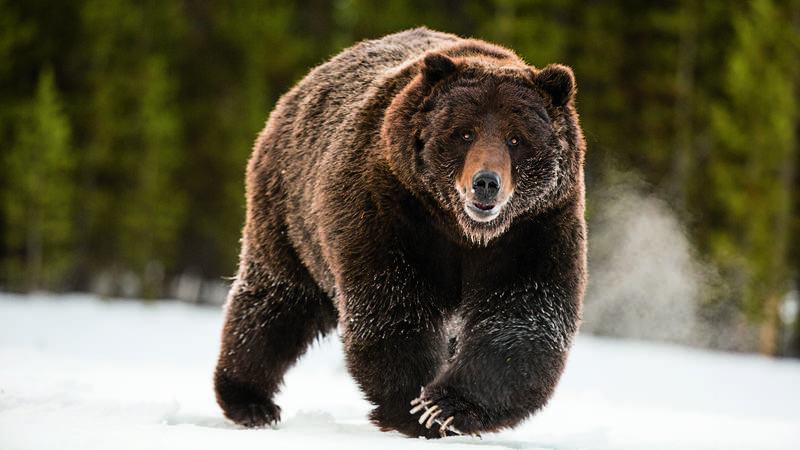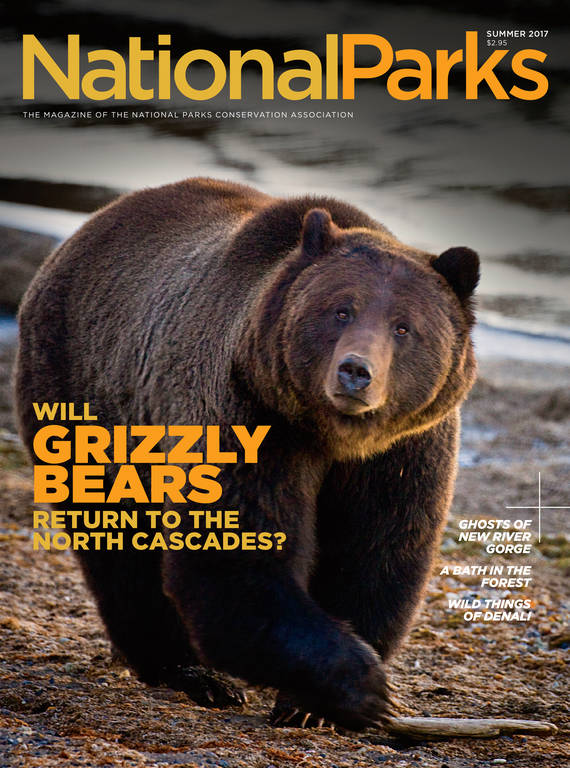Summer 2017
Lost Bears
Will grizzly bears return to the North Cascades?
Staggering under 60-pound backpacks, wildlife ecologist Bill Gaines and three other field scientists set off from the White River Trailhead in the North Cascades of Washington one July day. Along with their personal effects, they carried two 100-foot coils of barbed wire and several plastic bottles of what they called “goo,” a potent and hideous-smelling elixir made from road kill stewed over several months.
The team was searching for grizzly bears. These lumbering, intelligent omnivores once thrived in the North Cascades, eating plentiful salmon, berries, tubers, roots, deer and small mammals, but intensive fur trapping and predator control programs nearly wiped them out. The last confirmed sighting was in 1996, though many people claim unsubstantiated glimpses, leaving open the tantalizing possibility that they still haunt the mountains.
Since about 2008, Gaines, a trim 55-year-old with a fluffy mat of brown hair, has looked for them as an independent researcher for the U.S. Forest Service, National Park Service and U.S. Fish and Wildlife Service. With other scientists, he has set up more than 600 hair traps covering about 30 percent of the bears’ suitable habitat across the North Cascades. They’ve sent hairs to a specialized laboratory, piling up evidence of about 750 black bears, but not a single grizzly.
During that brilliantly clear July week, the small team tromped through slide alder thickets and subalpine meadows to Boulder Pass, then descended 4,000 vertical feet into the Napeequa Valley, a remote bowl marked by steep avalanche paths — perfect grizzly terrain. They slogged through the waist-high, bone-numbing waters of the Napeequa River with the help of ropes. Over a couple of days, they fashioned six hair traps out of barbed wire, a pile of sticks and a dollop of goo covered with bark.
“Pouring the goo is a special skill because you don’t want to get any on you,” said Gaines. “A drop will ruin your day, if not your week.” Finally, they flicked on remote cameras before embarking on the long walk back out again. A month later, the team members retraced their steps in a battering ram of a storm to retrieve the hair samples and cameras. They sent the fur to a lab with high hopes, but several months later, they received disappointing news: black bears again.
“On some days, it’s physically challenging and emotionally draining,” Gaines said. “It’s discouraging that we haven’t been able to find a bear. It’s also telling because it reinforces our idea that there’s not many left, and if we are going to get a recovered population here, we’re going to have to give them some help.”

The North Cascades ecosystem encompasses 13,600 square miles in the U.S. and British Columbia.
© KAREN MINOTGaines is one of many Washingtonians who hope to see grizzly bears return to their native range in the North Cascades ecosystem, which encompasses 9,800 square miles in the U.S., including North Cascades National Park and two national forests, as well as 3,800 square miles of contiguous land in British Columbia. Even though these rugged mountains have large swaths of prime grizzly habitat, with alpine meadows and more than 100 plant species the bears like to eat, grizzlies have not reappeared on their own. In the last 10 years, in the greater ecosystem, there have been only four confirmed sightings — all in British Columbia.
For more than 20 years, the Park Service and Fish and Wildlife Service have worked on a plan to resuscitate grizzly bear populations as part of a nationwide recovery of this threatened species. Bringing them back in the North Cascades would be good for their long-term survival. It would also be good for the North Cascades, because the bears help balance the ecosystem. They weed out injured and unfit deer, elk and small mammals, churn up alpine meadows when they dig for roots, and spread seeds, keeping plant and animal communities healthy.
Studies from ecosystems that have grizzlies suggest that they also benefit the economy, attracting tourists who’d like to see them. Grizzly bears feature in ceremonies and oral histories of several tribes in the area, and conservationists argue that, in general, there’s spiritual value in knowing that these animals live here.
“Grizzlies put the wild in wilderness,” said Rob Smith, Northwest regional director for NPCA. “The North Cascades remain a rare, special place because grizzly bears are still there. We can’t let them disappear on our watch.”
Like other large, charismatic species, grizzlies trigger intense emotions among both those who love them and those who fear them. As the effort to bring them back has gathered steam, so has the opposition. The debate intensified in January after the Park Service and Fish and Wildlife Service released a draft environmental impact statement with four potential strategies for restoring the bears to the ecosystem, three of which would actively reintroduce the animals.
The plan has sparked high hopes among wildlife and park supporters, who say the future of an ecosystem and a species hangs in the balance. Others, including some ranchers and government skeptics, feel their safety and livestock are at risk. After a host of public meetings and a comment period that ended in April, staff at the two agencies began reviewing public input. But as Park Service officials note, the decision isn’t about whether to bring grizzlies back. Under the Endangered Species Act, the federal government is committed to recovering them, so it’s a matter of how to bring them back in a way that works well for bears while also addressing human concerns. The agencies plan to release a final decision by the end of the year.
At one time, grizzly bears roamed half the continent, from coast to coast and from Mexico to Canada. Now they populate about 2 percent of their former range in the continental U.S. In the mid-19th century, fur trappers in Washington harvested just about every furry creature they could find — foxes, martens, wolves and grizzly bears. In the 1850s and 1860s alone, the Hudson’s Bay Company, a major fur trader, recorded nearly 4,000 grizzly hides streaming out of four trading posts situated near the Cascades.
Even under the best conditions, grizzlies reproduce slowly. Biologists believe that the population never recovered from the fur trading and government programs that systematically wiped out nature’s predators in the 19th and 20th centuries.
After the federal government listed the grizzly bear as threatened in the continental U.S. in 1975, the Fish and Wildlife Service approved a national recovery plan aimed at fostering viable populations in the greater Yellowstone ecosystem and parts of Montana, Idaho and Washington. The agency also identified the Bitterroot Range and North Cascades as possible recovery zones. After a long habitat assessment, the Interagency Grizzly Bear Committee, a group with representatives from federal and state agencies, decided to proceed with restoring grizzly bears in the North Cascades in 1991. But first, it had to determine if any grizzly bears still roamed the remote valleys in this fortress of peaks.
And so the search began. For years, biologists fielded 1-800 bear hotlines, but more than 90 percent of the calls turned out to concern black bear sightings. Every year, a handful of credible reports trickled in, but none could be confirmed. The photos were too grainy, or the bears were just dark dots in a vast landscape of ice and stone — or there were no photos at all. Occasionally, researchers, including Gaines, would respond to a promising sighting by hiking out to an area to set up a hair trap. Always nothing. Gaines has observed, over time, that the number of sightings has waned. “Small populations,” he said, “tend to wink out.”

In Yellowstone, where this photo was snapped, grizzlies are known to have killed only seven people in the past 145 years.
© RONAN DONOVAN/NATIONAL GEOGRAPHIC CREATIVEIn 2014, the Park Service and Fish and Wildlife Service finally secured funding to begin working on an environmental impact statement on grizzly bear restoration in the North Cascades. (It helped that then-director Jonathan Jarvis, who had worked as a biologist and chief of natural and cultural resources in North Cascades National Park, supported the project.) Agency staff hosted public meetings and solicited input from local residents, then released the draft in January.
The document presents four options for restoring the population and analyzes the potential effects of each on wildlife, visitor use and recreation, public safety and the local economy. In one alternative, the agencies would take no action but would continue managing public land as if there were grizzlies, maintaining bear-proof sanitation and educating the public on bear safety. The other three alternatives would require actively capturing bears from either Montana or British Columbia by using foot snares or culvert traps, or by sedating them with darts launched from helicopters. Biologists would then transport them into the North Cascades by helicopter to establish a self-sustaining population. The agencies would also increase public outreach and establish more proactive protocols for managing any nuisance bears.
The alternatives differ in how quickly they would reintroduce bears. The slower option calls for 10 bears at first (followed by a wait-and-see period); the fastest option involves bringing in five to seven bears annually until the population reaches 200. It could take anywhere from 25 to 100 years for the population to be self-sustaining, depending on which alternative is selected (Scientists don’t know precisely how big a population must be to be considered self-sustaining, but settled on the target number of 200.) NPCA supports the “incremental restoration” alternative, which would add five to seven grizzlies each of the first several years to establish a base population of 25 bears that would gradually grow to 200 by the end of the century.
The initial two-month comment period was extended by 45 days and ultimately netted 126,000 comments. In large part, the public supports reintroduction. During the 2015 comment period, letters backing grizzly bear recovery outnumbered those against it five to one. In a 2016 poll of 600 registered voters financed by Defenders of Wildlife, Tulchin Research found that 80 percent of respondents were in favor of helping the bears recover and 13 percent opposed it. (The survey didn’t specifically mention reintroduction.) Two previous surveys also suggested broad public approval of recovery. Still, some residents are vociferously opposed to plopping the huge mammals back into the system.
“If they show up, they show up,” said Doug England, a county commissioner in Chelan County in central Washington. “But the idea of hauling in grizzlies in helicopters just because someone from somewhere else thinks they should be there just goes against our grain.”
While locals are used to interacting with black bears — between 25,000 and 30,000 roam the state — England argues that grizzly bears are bigger and more aggressive, posing a greater safety risk. Some locals are concerned that their presence would effectively — or officially — close areas to hiking, fishing and other pursuits. Others are worried that the bears will wander into ranching areas and kill livestock, devastate orchards or saunter into towns looking for human food.
“If they don’t have the correct habitat, they will move to areas where there are more food sources — and those are areas where there is more human habitation,” said Ron Scutt, an educator in Stehekin who opposes grizzly reintroduction. “We need to ask ourselves: Are we setting the grizzlies up for failure?”
Jack Oelfke, chief of natural and cultural resources at North Cascades National Park, points out that in other ecosystems that harbor grizzlies, the bears kill livestock infrequently. In contrast to wolves, which are primarily meat eaters and hunt in packs, grizzlies are solitary and mostly vegetarian. Nonetheless, as grizzly bears recover in the North Cascades, the land-management agencies would support a program to compensate ranchers for occasional losses, perhaps in partnership with a nonprofit. If the agencies choose a reintroduction alternative, they would likely also develop cost-share programs that would help orchard owners purchase electric fences, which have proved effective at deterring bears. The Park Service also has said that any official closures hampering recreational access would be rare and brief, lasting between a few hours and a few days.
Perhaps the biggest issue, however, is concern about attacks. “Those fears are very primal,” Oelfke said, “so trying to address them is as challenging as anything in this process.” Oelfke has participated in the eight public meetings, which all offered attendees a chance to chat one-on-one with staffers. In all, more than 1,200 people showed up. At each, he spoke with both supporters and opponents, some of whom approached him looking angry.
“To be able to talk through the concerns calmly and with the facts helps in almost every case,” Oelfke said. “I think it also shows people that there are normal people behind this effort. We’re not just desk jockeys sitting behind a computer trying to drum up this crazy project. There’s a scientific basis.”
In fact, grizzlies can be aggressive when defending cubs or territory, but humans are seldom their prey and fatalities are rare. In Yellowstone, over the past 145 years, grizzlies have killed only seven people. (Or possibly eight — the species involved in one case is unclear.) A visitor there is almost as likely to be killed by a falling tree.
“To me, the more you know, the less you fear,” said Chris Morgan, a Bellingham-based ecologist and filmmaker who has documented bears across the world for shows such as “Planet Earth” and “Frozen Planet” and released two short videos about bears in the North Cascades, one sponsored by NPCA. “As soon as you know they’re smart and reasonable, your perception can change — and it changes into wonder.”

National Parks
You can read this and other stories about history, nature, culture, art, conservation, travel, science and more in National Parks magazine. Your tax-deductible membership donation of $25 or more entitles…
See more ›Bill Gaines isn’t advocating for a specific alternative. But he has worked to clear misperceptions of grizzlies through “Ghost Bears,” a presentation on his fieldwork that he has delivered dozens of times across the state. Even though he and other field biologists have yet to find a grizzly, the efforts aren’t for naught. Their data have helped them understand, among other things, the movements of black bears in the ecosystem and how highways act as barriers. Meanwhile, Gaines is still tromping out into the field to collect hair samples just in case a lone grizzly or two still ramble these toothy peaks.
“It sort of does feel like we’re looking for a ghost,” he said. “A few times, I’ve sat up on a high ridge looking over the Cascades thinking, ‘Man, this place is wild. And man, we just can’t find a grizzly bear.’ But I still think that there’s a bear or two out there in one of those remote valleys, and that possibility is exciting. That gives me hope to keep on going.”
To learn more about Friends of the North Cascades Grizzly Bear, a coalition of organizations including NPCA, go to northcascades.org.
About the author
-
 Kate Siber Contributor
Kate Siber ContributorKate Siber, a freelance writer and correspondent for Outside magazine, is based in Durango, Colorado. Her writing has appeared in National Geographic Traveler and The New York Times. She is also the author of “National Parks of the U.S.A.,” a best-selling children’s book.



